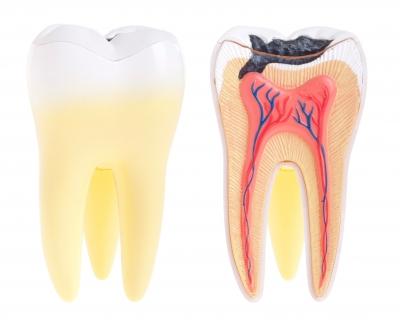Root Canal – What Is It Anyway?!

You’ve gone to the dentist because of a bad toothache and you hear the words “I’m sorry, but you’re going to need a root canal.” What does that mean? What should you expect? Will it hurt? First, take a deep breath – things will be fine.
First, let’s cover a little tooth anatomy. The outside shiny white part of your tooth that you can see is the enamel. This hard mineralized surface protects the tooth. Then as you look further inside there is the dentin. The dentin is slightly yellow, softer than enamel, and quite porous. Since it is softer than enamel, it decays more quickly, but it still serves to protect the pulp of the tooth and to provide structure for the crown of the tooth (the part above the gum line). At the innermost part of the tooth, there is the pulp. This soft tissue contains nerves and blood vessels that enter the tooth from a tiny hole at the bottom of the root. When people talk about the “nerve” of a tooth, they are usually referring to the pulp. The numbers of canals depend on both which tooth is involved and the individual person’s genes. Some teeth have just one canal while others may have as many as four or five canals!
If you have been told you need a root canal or endodontic therapy, it means that the pulp has been infected and needs to be removed. If left untreated, the infection in the tooth can lead to an abscess and the infection can spread throughout your mouth, face, and neck. Sometimes the dentist will prescribe antibiotics to try and heal the infection in the hopes that a root canal will not be needed. Sometimes the antibiotics will be prescribed for a few days so that the infection can be lessened before the root canal. And sometimes the antibiotics will be prescribed after the root canal. Your dentist can explain your individualized situation based on your x-rays and diagnosis. Depending on the location of the infected tooth or the severity of the infection, your dentist at Library Park Dental may refer you to an endodontic specialist for treatment, or you may be seen at our office.
Your dentist will numb the area around the tooth so that you do not feel anything. Then a rubber dam is placed so that the tooth is isolated and bacteria in your saliva do not get down into the tooth. An opening is made in the tooth to access the pulp. Your dentist will use specialized instruments to carefully remove the pulp tissue and infection. Several irrigants will be placed to further clean the canals. After taking a new x-ray to make sure that the entire canal has been accessed, the dentist will fill the canals with an inert material and then will seal the tooth.
Many teeth that have root canal therapy will need a crown. The pulp contains the blood supply for the tooth, and without that supply the tooth becomes brittle. A crown is placed to keep a tooth from breaking and causing more problems.
Your dentists at Library Park Dental don’t want to have to tell you that a root canal is needed, but be assured that if it is needed you are in good hands!
